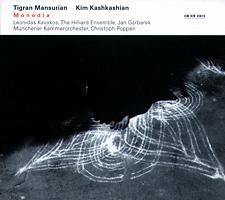
Less is more
Tigran Mansurian's
'Monodia' -
appreciated by
REX HARLEY'The performance is exemplary.'
|

|
This is the second CD within the last year from ECM to feature the work of Armenian composer Tigran Mansurian. The first, Heyren, was a novel concoction devoted mainly to interpretations of songs by the earlier Armenian composer, priest and ethnomusicologist, known simply as Komitas. Much of the work on this earlier disc is extremely beautiful and, indeed, haunting. What divided critics and listeners was the decision to have Mansurian himself 'sing' some of the pieces. Anyone who has heard the results will understand the use of quotation marks here. Mansurian openly refers to 'my poor voice', and in orthodox performance terms there can be no arguing with his own assessment. The division of opinion comes from those who would leave it at that, and others, including the producers at ECM, who feel that there is a certain authenticity and a raw emotional power which overrides purely aesthetic concerns. My own opinion is equally equivocal: it depends entirely on my state of mind at the time of listening.
By contrast, Monodia is a straightforward presentation of four extended pieces by the composer, dating from the early 1980s to the late 90s. The first, '... and then I was in time again'
[listen -- CD1 track 2, 5:11-6:20],
is a concerto for viola and string orchestra, in two movements, featuring Kim Kashkashian, also his main collaborator on Heyren. The title comes from William Faulkner's The Sound and the Fury, a novel whose stream-of-consciousness technique has made a lasting impression on the composer. It's an elusive and enigmatic piece, challenging to listen to and demanding several hearings in order to grasp its fugitive sound-world.
Continue >>
Copyright © 19 September 2004
Rex Harley, Cardiff UK

|

